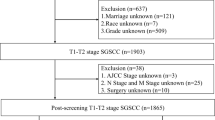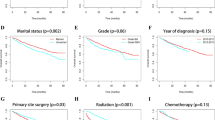Abstract
Objectives
The study aimed to construct prognostic models for OS and CSS in patients with T1N0M0 glottic SCC. In addition, we used PSM to re-assess the effect of surgery alone and radiation alone.
Methods
The Surveillance, Epidemiology, and End Results database was searched for patients with confirmed T1N0M0 glottic SCC. Patients with complete data were randomly divided into the training and the validation cohort (7:3), Cox-regression analysis was performed to identified significant predictors of OS and CSS. PSM was used to mimic randomized controlled the trials. Kaplan–Meier survival method and log-rank tests were utilized for survival analysis.
Results
A total 1827 patients met the inclusion criteria. Survival analysis indicated that the patients who underwent the primary site surgery had a better OS (P = 0.002) and CSS (P = 0.008), compared with non-surgery patients. Cox-regression analysis proved that age, marital status, T1 stages, surgery, radiation, sequential treatments, and chemotherapy had significant effects on OS. While age, marital status, histologic grade, surgery, radiation, sequential treatments, and chemotherapy were substantially associated with CSS. Patients who received primary site surgery had a better OS and CSS, compared with non-surgical patients. Patients receiving radiation had a better CSS than non-radiation patients. However, patients who received sequential treatments or chemotherapy had a worse OS and CSS, compared with controlled groups. Predictive nomogram models were established to predict patients’ prognosis with good consistency between the actual observation and the nomogram prediction. Before PSM, patients who underwent surgery alone had a better OS and CSS than those who received radiation alone. After PSM, patients receiving surgery still had a better OS than those receiving radiation. However, there were no statistically significant differences in CSS.
Conclusions
Nomogram models were developed to predict OS and CSS in patients with T1N0M0 glottic SCC. Primary site surgery could definitely increase OS and CSS, while radiation could significantly increase CSS. Using PSM, surgery alone could significantly enhance OS, as compared to radiation alone. Chemotherapy should not be recommended for early glottic carcinoma.






Similar content being viewed by others
Abbreviations
- OS:
-
Overall survival
- CSS:
-
Cancer-specific survival
- PSM:
-
Propensity-score matching
- SEER:
-
Surveillance, Epidemiology, and End Results
- SCC:
-
Squamous cell carcinoma
- AUC:
-
Area under curve
References
Remmelts AJ, Hoebers FJ, Klop WM et al (2013) Evaluation of lasersurgery and radiotherapy as treatment modalities in early stage laryngeal carcinoma: tumour outcome and quality of voice. Eur Arch Otorhinolaryngol 270:2079–2087. https://doi.org/10.1007/s00405-013-2460-x
Elicin O, Giger R (2020) Comparison of current surgical and non-surgical treatment strategies for early and locally advanced stage glottic laryngeal cancer and their outcome. Cancers (Basel) 12:732. https://doi.org/10.3390/cancers12030732
Tulli M, Re M, Bondi S et al (2020) The prognostic value of anterior commissure involvement in T1 glottic cancer: a systematic review and meta-analysis. Laryngoscope 130:1932–1940. https://doi.org/10.1002/lary.28395
Sjögren EV, Wiggenraad RG, Le Cessie S et al (2009) Outcome of radiotherapy in T1 glottic carcinoma: a population-based study. Eur Arch Otorhinolaryngol 266:735–744. https://doi.org/10.1007/s00405-008-0803-9
Warner L, Chudasama J, Kelly CG et al (2014) Radiotherapy versus open surgery versus endolaryngeal surgery (with or without laser) for early laryngeal squamous cell cancer. Cochrane Database Syst Rev. https://doi.org/10.1002/14651858.CD002027.pub2
Yoo J, Lacchetti C, Hammond JA et al (2014) Role of endolaryngeal surgery (with or without laser) versus radiotherapy in the management of early (T1) glottic cancer: a systematic review. Head Neck 36:1807–1819. https://doi.org/10.1002/hed.23504
Luo MS, Huang GJ, Liu HB (2020) Prognostic factors of patients with initially diagnosed T1a glottic cancer Novel nomograms and a propensity-score matched cohort analysis. Medicine 99:e2304. https://doi.org/10.1097/MD.0000000000023004
Murakami R, Nishimura R, Baba Y et al (2006) Concurrent chemoradiation therapy with low-dose CDDP and UFT for glottic carcinomas: evaluation using the sixth edition of the UICC TNM staging system. Acta Oncol 45:162–167. https://doi.org/10.1080/02841860500490269
Al FK, Youssef BY, Mohamed A et al (2020) Outcomes after radiation therapy for T2N0/stage II glottic squamous cell carcinoma. Head Neck 42:2791–2800. https://doi.org/10.1002/hed.26308
Jacobi C, Freundorfer R, Reiter M (2019) Transoral laser microsurgery in early glottic cancer involving the anterior commissure. Eur Arch Otorhinolaryngol 276:837–845. https://doi.org/10.1007/s00405-018-5261-4
Katz SJ (2015) Cancer care delivery research and the National Cancer Institute SEER Program: challenges and opportunities. JAMA Oncol 1:677–678. https://doi.org/10.1001/jamaoncol.2015.0764
Renehan AG, Malcomson L, Emsley R et al (2016) Watch-and-wait approach versus surgical resection after chemoradiotherapy for patients with rectal cancer (the OnCoRe project): a propensity-score matched cohort analysis. Lancet Oncol 17:174–183. https://doi.org/10.1016/S1470-2045(15)00467-2
Jones EA, Shuman AG, Egleston BL et al (2019) Common pitfalls of head and neck research using cancer registries. Otolaryngol Head Neck Surg 161:245–250. https://doi.org/10.1177/0194599819838823
Huang GJ, Yang BB (2021) Prognostic risk factors for initially diagnosed T2N0M0 glottic cancer: competing risk analysis and propensity-score matched cohort analysis. Eur Arch Otorhinolaryngol 278:3921–3931. https://doi.org/10.1007/s00405-020-06557-9
Zhan C, Yang X, Song X et al (2018) Radiotherapy vs surgery for T1–2N0M0 laryngeal squamous cell carcinoma: a population-based and propensity score matching study. Cancer Med 7:2837–2847. https://doi.org/10.1002/cam4.1525
de Carvalho GB, Kohler HF, de Mello JBH et al (2021) Organ preservation and oncological outcomes in early laryngeal cancer: a propensity score-based study. Acta Otorhinolaryngol Ital 41:317–326. https://doi.org/10.14639/0392-100X-N0870
Balachandran VP, Gonen M, Smith JJ et al (2015) Nomograms in oncology: more than meets the eye. Lancet Oncol 16:e173–e180. https://doi.org/10.1016/S1470-2045(14)71116-7
Harrell FE Jr, Lee KL, Mark DB (1996) Multivariable prognostic models: issues in develo** models, evaluating assumptions and adequacy, and measuring and reducing errors. Stat Med 15:361–387. https://doi.org/10.1002/(SICI)1097-0258(19960229)15:4%3c361::AID-SIM168%3e3.0.CO;2-4
Kramer AA, Zimmerman JE (2007) Assessing the calibration of mortality benchmarks in critical care: the Hosmer-Lemeshow test revisited. Crit Care Med 35:2052–2056. https://doi.org/10.1097/01.CCM.0000275267.64078.B0
Shah JP, Karnell LH, Hoffman HT et al (1997) Patterns of care for cancer of the larynx in the United States. Arch Otolaryngol Head Neck Surg 123:475–483. https://doi.org/10.1002/hed.25430
Ferlito A, Bradley PJ, Rinaldo A (2004) What is the treatment of choice for T1 squamous cell carcinoma of the larynx? J Laryngol Otol 118:747–749. https://doi.org/10.1016/j.jcms.2020.09.011
Abdurehim Y, Hua Z, Yasin Y et al (2012) Transoral laser surgery versus radiotherapy: systematic review and meta-analysis for treatment options of T1a glottic cancer. Head Neck 34:23–33. https://doi.org/10.1002/hed.21686
van Loon Y, Sjögren EV, Langeveld TP et al (2012) Functional outcomes after radiotherapy or laser surgery in early glottic carcinoma: a systematic review. Head Neck 34:1179–1189. https://doi.org/10.1002/hed.21783
Forastiere AA, Ismaila N, Lewin JS et al (2018) Use of larynx-preservation strategies in the treatment of laryngeal cancer: American society of clinical oncology clinical practice guideline update. J Clin Oncol 36:1143–1169. https://doi.org/10.1200/JCO.2017.75.7385
Shelan M, Anschuetz L, Schubert AD et al (2017) T1–2 glottic cancer treated with radiotherapy and/or surgery. Strahlenther Onkol 193:995–1004. https://doi.org/10.1007/s00066-017-1139-4
Huang G, Luo M, Zhang J et al (2017) Laser surgery versus radiotherapy for T1a glottic carcinoma: a meta-analysis of oncologic outcomes. Acta Otolaryngol 137:1204–1209. https://doi.org/10.1080/00016489.2017.1353706
Mo HL, Li J, Yang X et al (2017) Transoral laser microsurgery versus radiotherapy for T1 glottic carcinoma: a systematic review and meta-analysis. Lasers Med Sci 32:461–467. https://doi.org/10.1007/s10103-016-2103-8
Chung SY, Lee CG (2020) Feasibility of single vocal cord irradiation as a treatment strategy for T1a glottic cancer. Head Neck 42:854–859. https://doi.org/10.1002/hed.26052
Canis M, Ihler F, Martin A et al (2015) Transoral laser microsurgery for T1a glottic cancer: review of 404 cases. Head Neck 37:889–895. https://doi.org/10.1002/hed.23688
Mendenhall WM, Werning JW, Hinerman RW et al (2004) Management of T1–T2 glottic carcinomas. Cancer 100:1786–1792. https://doi.org/10.1002/cncr.20181
Thurnher D, Erovic BM, Frommlet F et al (2008) Challenging a dogma-surgery yields superior long-term results for T1a squamous cell carcinoma of the glottic larynx compared to radiotherapy. Eur J Surg Oncol 34:692–698. https://doi.org/10.1016/j.ejso.2007.06.008
Stoeckli SJ, Schnieper I, Huguenin P et al (2003) Early glottic carcinoma: treatment according patient’s preference? Head Neck 25:1051–1056 (Https://doi.org/10.1002/hed.10323)
Schrijvers ML, van Riel EL, Langendijk JA et al (2009) Higher laryngeal preservation rate after CO2 laser surgery compared with radiotherapy in T1a glottic laryngeal carcinoma. Head Neck 31:759–764. https://doi.org/10.1002/hed.21027
Higgins KM, Shah MD, Ogaick MJ et al (2009) Treatment of early-stage glottic cancer: meta-analysis comparison of laser excision versus radiotherapy. J Otolaryngol Head Neck Surg 38:603–612
Bron LP, Soldati D, Zouhair A et al (2001) Treatment of early stage squamous-cell carcinoma of the glottic larynx: endoscopic surgery or cricohyoidoepiglottopexy versus radiotherapy. Head Neck 23:823–829. https://doi.org/10.1002/hed.1120
Bledsoe TJ, Park HS, Stahl JM et al (2017) Hypofractionated radiotherapy for patients with early-stage glottic cancer: patterns of care and survival. J Natl Cancer Inst. https://doi.org/10.1093/jnci/djx042
Brouha XDR, Op De Coul B, Terhaard CHJ et al (2000) Does waiting time for radiotherapy affect local control of T1N0M0 glottic laryngeal carcinoma? Clin Otolaryngol 25:215–218. https://doi.org/10.1046/j.1365-2273.2000.00347.x
Gultekin M, Ozyar E, Cengiz M et al (2011) High daily fraction dose external radiotherapy for T1 glottic carcinoma: treatment results and prognostic factors. Head Neck 34:1009–1014. https://doi.org/10.1002/hed.21860
Yamazaki H, Nishiyama K, Tanaka E et al (2006) Radiotherapy for early glottic carcinoma (T1N0M0): results of prospective randomized study of radiation fraction size and overall treatment time. Int J Radiat Oncol Biol Phys 64:77–82. https://doi.org/10.1016/j.ijrobp.2005.06.014
Mendenhall WM, Amdur RJ, Morris CG et al (2001) T1–T2N0 squamous cell carcinoma of the glottic larynx treated with radiation therapy. J Clin Oncol 19:4029–4036. https://doi.org/10.1200/JCO.2001.19.20.4029
Jayakrishnan TT, White RJ, Greenberg L et al (2019) Predictors of chemotherapy and its effects in early stage squamous cell carcinoma of the larynx. Laryngosc Investig Otolaryngol 5:445–452. https://doi.org/10.1002/lio2.327
Funding
NO.
Author information
Authors and Affiliations
Contributions
WM: conception of the work, data collection, data analysis and interpretation, drafting the article, critical revision of the article, and final approval of the version to be published. JJZ, JBH and JHC: conception of the work.
Corresponding author
Ethics declarations
Conflict of interest
The authors declare that the research was conducted in the absence of any commercial or financial relationships that could be construed as a potential conflict of interest.
Ethical approval
The research involves human participants and all procedures performed in the study involving human participants were in accordance with the ethical standards of the institutional and/or national research committee and with the 1964 Helsinki Declaration and its later amendments or comparable ethical standards.
Informed consent
The SEER database are publicly available. Informed consent was obtained from all individual participants included in the study.
Additional information
Publisher's Note
Springer Nature remains neutral with regard to jurisdictional claims in published maps and institutional affiliations.
Rights and permissions
Springer Nature or its licensor (e.g. a society or other partner) holds exclusive rights to this article under a publishing agreement with the author(s) or other rightsholder(s); author self-archiving of the accepted manuscript version of this article is solely governed by the terms of such publishing agreement and applicable law.
About this article
Cite this article
Ming, W., Zuo, J., Han, J. et al. Establishment of prognostic nomogram for T1N0M0 glottic squamous cell carcinoma: an SEER database analysis. Eur Arch Otorhinolaryngol 280, 2397–2410 (2023). https://doi.org/10.1007/s00405-022-07763-3
Received:
Accepted:
Published:
Issue Date:
DOI: https://doi.org/10.1007/s00405-022-07763-3




